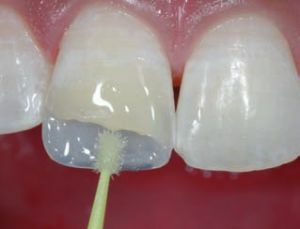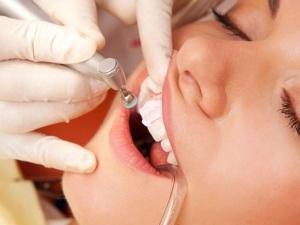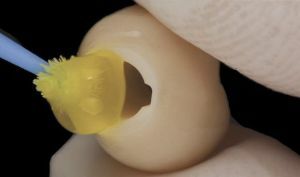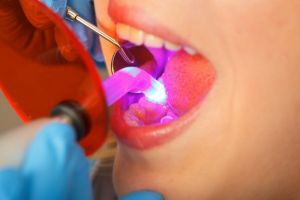 One of the modern procedures used in dentistry is tooth bonding. The essence of this method consists in applying to the enamel a special polymer gel, which when solidified is firmly fixed in the tissues and becomes indistinguishable from the tooth itself.
One of the modern procedures used in dentistry is tooth bonding. The essence of this method consists in applying to the enamel a special polymer gel, which when solidified is firmly fixed in the tissues and becomes indistinguishable from the tooth itself.
Thus, with the help of bonding, you can restore the original structure of the enamel, for example, remove chips, color defects, and also correct cosmetic imperfections, such as a pronounced gap between the upper front teeth.
Contents
- Scope of application
- Scope of application
- Types of procedures
- Features of
- treatment process Positive and negative aspects of this method
- Questions and Answers
- Average cost in Russia
Scope of use
Nowadays, polymeric materials are used not only in cosmetic dentistry aimed at improving color and shapeteeth. In fact, bonding is a much more multi-faceted procedure:
- the composite materials used can be used to treat caries of any complexity, since they are convenient to fill the cleaned cavities after opening the channels;
- for people with abnormal bite bonding can be a solution to problems associated with irregular shape and length of chewing teeth;
- with the help of polymeric materials can hide traces of dental treatment, remove chipped and give the enamel a more natural color;
- with innovative gel protects the exposed roots in the case of a number of diseases leading to deformation of the gums.
So, bonding is a fairly universal method of correcting the shape and color of teeth, which is used in many cases.
Varieties of procedures
The method differs mainly in the volume of material applied to the hard tissue. 
With superficial intervention, the doctor basically applies a little composite gel to the front of the tooth enamel in order to correct a small defect, color correction or to protect the tooth from possible damage in the future.
Deep intervention involves applying pre-made materials in the laboratory to almost the entire surface of the tooth or even filling the gel with cavities in it. This procedure will require two visits to the dentist.
During the first visit to the specialist, a mold will be made, on the basis of which the material will be made in the laboratory. The second procedure will be performed by the procedure itself.
Features of the treatment process
Correction of the dentition with bonding occurs according to the following scheme:
- before the procedure, the physician selects materials, guided by the color scale;
- then the dentist prepares the tooth surface, making it a little rough for a larger bond of enamel with composite materials;
- after that also for greater strength on the surface a special conditioner is applied;
- then layer by layer the dentist spreads the polymer material and allows it to solidify with the help of an ultraviolet lamp;
- at the last stage the dentist smooths the resulting surface and conducts its final processing, giving the necessary shape and dimensions to the teeth.
Usually it takes about one hour to bond one tooth. This procedure is painless, except for cases when polymeric materials are used in the treatment of caries.
Positive and negative aspects of this method
Like any other medical procedure, bonding has strengths and weaknesses. However, the advantages of treating such  method are much greater than the drawbacks:
method are much greater than the drawbacks:
- is the main plus is the minimal damage to enamel in comparison with the installation of crowns and veneers;The
- procedure does not require a strong boring of the surface of the exposed tooth and adjacent chewing organs;
- often the whole process fits into one visit to the doctor and does not require any preparatory work in the dental laboratory;
- after the procedure on the cured teeth there are no traces of dentist intervention.
However:
- polymeric materials are not as strong as crowns or fillings, so after bonding the probability of cleavage or even complete destruction of the structure may be somewhat larger than after restoring the teeth in other ways.
- also used gels are not as resistant to shade changes as crowns.
Thus, the ratio of advantages and disadvantages of the procedure make bonding a good option for correcting small chipping and damage, as well as to eliminate cosmetic defects. However, for deep restoration of the tooth surface and giving it greater strength, it is better to use crowns.
Questions and Answers
The most popular questions on the topic.
Do I have to take special care of the tooth on which the composite materials are applied?
The procedure does not involve any additional care for the oral cavity.
Are there any restrictions after the treatment?
In order for the material not to crumble, it is necessary to minimize the load on the prone teeth. Particularly contraindicated are bad habits: gnaw nails, caps of handles, prick nuts and seeds and so on.
What is the service life of the materials used?
Usually dentists guarantee the durability of applied materials for three to five years. However, on average, most patients have a lifespan of up to ten years.
Average cost in Russia
 Bonding is quite democratic in its price procedure, in our country, the correction of one tooth will require an average of 2 to 4 thousand rubles, depending on the complexity of the particular case.
Bonding is quite democratic in its price procedure, in our country, the correction of one tooth will require an average of 2 to 4 thousand rubles, depending on the complexity of the particular case.
Thus, bonding is a good alternative to the installation of crowns and one of the best methods of cosmetic correction of the dentition, which does not involve serious interference in its natural structure.
Whether this method is suitable for you or not - it is better to find out from your treating dentist, because along with the advantages the method has its drawbacks.
